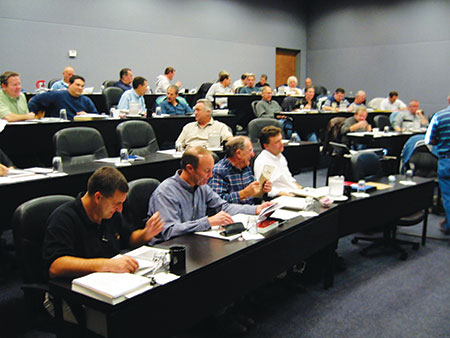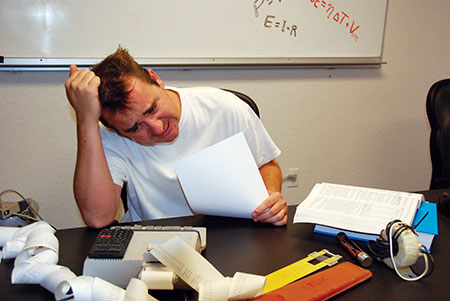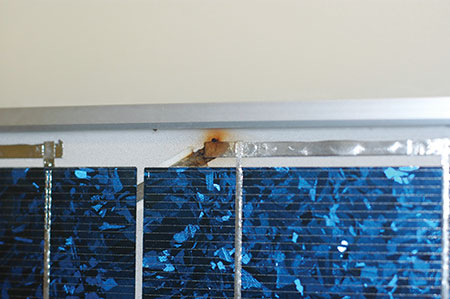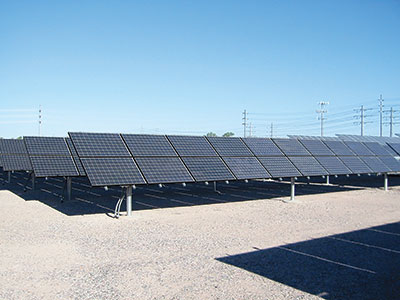Photovoltaic Power systems first appeared in the 1984 National Electrical Code and at that time, the equipment was somewhat simple, and the full impact of the new technology on the existing electrical power and distribution systems was not fully realized. Even though the US Department of Energy was investigating utility-interactive PV systems at facilities like the one I work at, the high cost of components and equipment in those early years resulted in few PV systems being installed, and most of those were in off-grid, remote locations that were not being inspected. Move forward to the 1988–1989 timeframe when the California rebate payments for PV installations started a drive for the widespread use of renewable energy systems that continues to this day and is enhanced by the need for solutions to global warming.
Along with the evolution of PV equipment and systems, the NEC has evolved as have the safety standards published by Underwriters Laboratories (UL). Most of the readers of IAEI magazine are familiar with the NEC revision process and may also be somewhat aware of the way UL Standards are developed. This article will cover some of the behind-the-scenes activities that occur along with the more formal process of developing the Code and the UL standards (photo 1).

The National Electrical Code
The normal Code development process of public proposals, Code Making Panel (CMP) meetings, public comments, more CMP meetings, CMP ballots and review by the NFPA Technical Correlating Committee (TCC) is only a small, but highly important part in the development of each new edition of the NEC. I use the term “small” with no disrespect to the members of the various CMPs and the TCC, but the number of behind-the-scenes hours devoted to developing proposals far exceeds the time spent in the formal process. The increasing number of proposals each code cycle, at least for PV, gives some indication of the magnitude of the effort. I suspect, that while all sections of the NEC are important, the rapidly changing PV technologies have dictated that significantly longer periods of intense labor have been directed to getting the Code changed in Articles 690 and 705.
There are people who scrutinize each section of Article 690 and Article 705 for grammatical errors and inconsistences in language and make proposals to change the perceived errors. There are individual engineers and AHJs looking at the technical content of the Code, the capabilities of equipment being used, and the commonly used installation methods and proposing updates to the Code. There are individuals who routinely propose changes to 690 and 705 based on other articles in the Code that may have no bearing whatsoever on the unique characteristics of PV systems. And then, there are the more detailed proposals associated with new PV equipment and new safety requirements developed by relatively large working groups of people (photo 2).

Examples of these relatively new or changing areas in 690 and 705 include DC PV Arc Fault Circuit Interrupters (690.11), PV Rapid Shutdown Systems (690.12), PV Grounding Requirements, Utility Interconnections (705.12) and a few others.
Take the development of the requirement for the PV Rapid Shutdown System (PVRSS) (690.12) as an example. The original requirement was initiated by the Fire Service to provide an additional degree of safety for Fire Service personnel responding to and fighting fires on buildings that had the always energized (in daylight) up to 600-volt dc PV source circuits across the roof and through the building. Those dc PV circuits are not de-energized when the ac power to the building is disconnected and remain a safety hazard. There was no off-the-shelf equipment being used or that was available that met the requirement except the use of AC PV Modules or microinverters. These devices appeared to meet the requirement by having no high voltage dc circuits, and their ac outputs would be turned off when the ac power to the building was turned off.
The Fire Service had numerous conference calls and webinars attended by interested individuals including people who were knowledgeable about the characteristics of PV systems and what capabilities could be achieved. The NFPA appointed a task group to develop a proposal for the 2014 NEC and at the same time, PV equipment manufacturers worked on a separate proposal. Numerous telephone conference calls and webinars were held on both sides, and proposals were submitted. And, as in many real-life scenarios, the result was a compromise for both sides. The Fire Service wanted the array voltages reduced at each PV module while the PV Industry felt that that requirement was impractical at the present time and that the high voltages within the array boundary were acceptably safe. The result is what you see in the 2014 NEC Section 690.12. And, the discussions and debate continue throughout the 2017 NEC development cycle. With 20–60 people on the multiple conference calls or webinars, the hours devoted to this one section of the code probably went into the thousands, even before any formal proposals were drafted. And at times, individual efforts were involved (photo 3).

Along with these two competing proposals submitted to the Code Making Panel, there were other proposals related to this section. Unfortunately, the weeklong code making process at Hilton Head, North Carolina, is pretty frantic. Although the proposals have been sent to the Code Making Panel members for review before the meeting, each proposal gets only a minute or two for discussion and review (with no time for detailed discussion) due to the tremendous number of proposals and comments that have been submitted and the limited time available for the meeting.
Similar efforts were involved in other sections of 690 and 705 that involved new equipment, new capabilities or new installation requirements such as grounding where the preponderance of non-isolated (transformerless) PV inverters appear to dictate that the concept of grounding needs considerable revision.
UL Safety Standards
UL Safety Standards are developed to ensure that equipment certified (listed) to these standards can be installed according to the installation requirements found in the NEC, thereby yielding an essentially hazard free electrical installation. In the days preceding electronic power equipment (yes, that was even before my time), application of the Code requirements was relatively straightforward: Connect conductors to passive devices like switches and overcurrent devices, and transformers. Many electricians could do that with a little training, and even the inspections were relatively easy.
However, we are now faced with active electronic power processing equipment scattered throughout our electrical power systems, and PV systems are no exception. We now must ensure that active inverters, active charge controllers, rapid shutdown equipment, DC PV arc-fault circuit interrupters, and even microinverters and AC PV modules plus module level electronics are properly installed and that they will operate safely. Many of these devices have multiple inputs and outputs and require not only electrical connections to the rest of the electrical circuit, but also careful adjustments of software and hardware driven internal parameters to operate safely.
Each of these active devices, made by numerous manufacturers, has different requirements for safe installation. It is neither possible nor practical to put detailed instructions in the Code for the installation and adjustment of each of these types of devices. The Code would become far too ponderous to deal with in its present form. For this complex equipment, the best the Code can do is refer to section 110.3(B) that requires that the instructions and labels provided on certified (listed) equipment be used and followed to properly install that equipment. This requirement in the NEC places a significant burden for ensuring the safe installation directly on the quality and detail of the equipment installation instructions that are required by the UL Standard for that equipment. These standards must be detailed and understandable because several Nationally Recognized Testing Laboratories (NRTLs) other than UL such as TUV, ETL and CSA will be using them to test and evaluate PV equipment (photo 4)

This discussion leads us to the effort required to develop these standards. Although Underwriters Laboratories publishes the standards, the various UL Standards Technical Panels (STP) write them. The STP is composed of a balanced a group of manufacturers, AHJs, technical experts, users, government agencies, and general interest individuals. These groups, in some cases, may include more than 50 people. There are standards and STPs for each of the major categories of equipment in PV systems. These include UL 1741 for inverters (including charge controllers, microinverters, rapid shutdown equipment, and AC PV modules), UL 1703 for PV modules, UL 1699B for DC PV arc fault circuit interrupters, UL 4703 for single conductor PV cable, UL 6703 for PV connectors, UL 2703 for PV racks, UL 489B for DC PV overcurrent devices, and others.

In many cases, the requirements in the standards are so complex that the entire STP does not, as a group, develop them. Various working groups are set up composed of STP members and other technically competent interested parties to draft sections of the standard. After those drafts are edited to comply with UL writing standards, they are presented to the STP for review, final refinement, balloting and integration into the whole standard. An example is the just-completed draft standard for the Code requirement in 690.12 for a PV Rapid Shutdown System (PVRSS).
Underwriters Laboratories engineers developed the basic outline and the initial contents for the draft PVRSS standard and published them as a Certifications Requirements Decision (CRD) in March of 2015. UL then formed a working group outside of the STP to further refine this draft. The working group, consisting of more than 50 people, met on a weekly basis via webinar for more than nine months to investigate, evaluate, and develop the requirements for the PVRSS based on the very limited requirement stated in Section 690.12 of the 2014 NEC.
The working group had to consider all possible ways in which various equipment manufacturers could implement the Code requirement. Since this PVRSS system provides a life safety function, the testing and evaluation criteria that the standard required would have to be rigorous, extensive, detailed, and very complex. The PVRSS system may have to work properly in the outdoor PV system environment that includes wide extremes of temperature, humidity, UV irradiation, wind, snow, ice, and blowing dirt. The standard must require testing to evaluate PVRSS and PV Rapid Shutdown Equipment (PVRSE) under all of these conditions plus surges that might occur from nearby lightning strikes on the connected ac and dc circuits. And the PVRSS equipment must operate reliably for the 40-50-year life of the system. While there are UL Standards to evaluate some of these conditions, and those standards were referenced in this new PVRSS Standard, the unique nature of the outdoor PV environment required that new testing and evaluation procedures be developed.
Even simple products such as power relays or contactors that have been listed to various UL Standards for the necessary voltage and current have not been tested in the very wide temperature extremes found in the PVRSS application. Electronic devices must be evaluated for new types of failure modes such as operation in high humidity environments and the response when control circuits fail or are interrupted.
The draft standard is 20 pages long and, after review and modification by the UL 1741 STP, it will be added to the UL 1741 Standard that is already 144 pages long.
Harmonization with International Standards
PV equipment is frequently designed and manufactured to be sold and installed in an international market. The equipment must meet the codes and standards of each country. While there is some variation in the electrical codes between countries that have such codes, the connections of PV equipment to those electrical systems is not too different from country to country. Some editions of the NEC have been translated into other languages (photo 5). Unfortunately, the standards governing how the equipment is built and tested differ significantly from country to country. There has been a long-term, on-going effort to harmonize the safety and construction standards of PV equipment between various countries.
Such a harmonized standard would reduce the manufacturer’s costs of certification and listing in multiple countries. Engineers from the US have participated in the development of these international standards that are published by International Electrotechnical Commission (IEC) (a French organization). The international standard, by its very nature, mainly addresses the common requirements that apply in all countries to the design and testing of the PV system electrical equipment. After the IEC Standard is published formally, it is distributed to the various countries where they evaluate it and add sections to the standard that elaborate on the “Country Differences” that will be used along with the common International Standard requirements to evaluate products in a particular country.
So, as the US safety standards become harmonized with the international standards, working groups here in the US spend two to three times as long developing the international standards as they would a US-only standard. The working groups first develop the US standard, and it is published as a UL Standard. Then they work on the international standard, and finally, they develop the “Country Differences” when the international standard is published. A very long process involving possibly hundreds of people and thousands of blood, sweat and tears hours. All of this to ensure that the PV equipment can be installed according to the requirements in the NEC and will operate safely when so installed.
And now, the AHJ should have a better idea why the instructions provided with a listed product are critical and why those instructions must be reviewed during the permitting, plan review, and inspection process to ensure a safe and code-compliant installation of a PV system.
Summary
The equipment used in PV systems is inherently complex; far too complex to have the complete installation instructions published in the NEC for much of the equipment being installed. Section 110.3(B) provides the guidance for this complex equipment by requiring that the instructions and labels for this listed equipment be followed. Those instructions will address the mechanical installation, the electrical installation, and any adjustments to the equipment that are required for its proper operation.
Many thousands of hours are devoted to developing the UL and International Safety Standards that determine how the equipment will be constructed and tested to ensure that it can operate safely when installed according to the instruction manual and the requirements in the NEC.
Inspectors and Plan Reviewers should require that copies of all instruction manuals be submitted with the permit application for a PV system, and those manuals should be reviewed to ensure that the system has been installed correctly. With no maintenance requirements in the NEC, we have only one chance to get it right—the electrical inspection of the installation.
About the author
The author has retired from the Southwest Technology Development Institute at New Mexico State University but is devoting about 25% of his time to PV activities in order to keep involved in writing these “Perspectives on PV’ articles in the IAEI magazine and to stay active in the NEC and UL Standards development process. Seven to eight-hour presentations are still available on PV and the Code, and they cover 2008-2014 NEC requirements. He can be reached at e-mail: jwiles@nmsu.edu, phone: 575-646-6105
For More Information
The Southwest Technology Development Institute web site maintains a PV Systems Inspector/Installer Checklist and all copies of the previous “Perspectives on PV” articles for easy downloading. A color copy of the latest version (1.93) of the 150-page, Photovoltaic Power Systems and the 2005 National Electrical Code: Suggested Practices, written by the author, may be downloaded from this website: http://www.nmsu.edu/~tdi/Photovoltaics/Codes-Stds/Codes-Stds.html.















Find Us on Socials